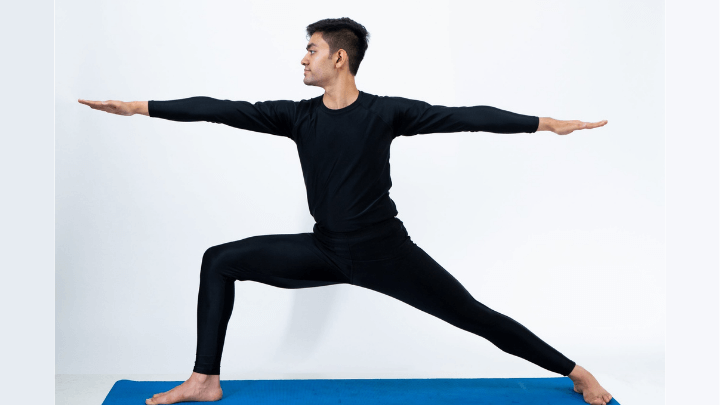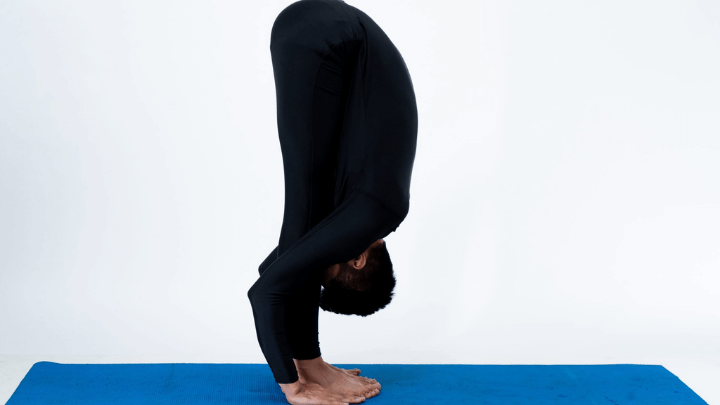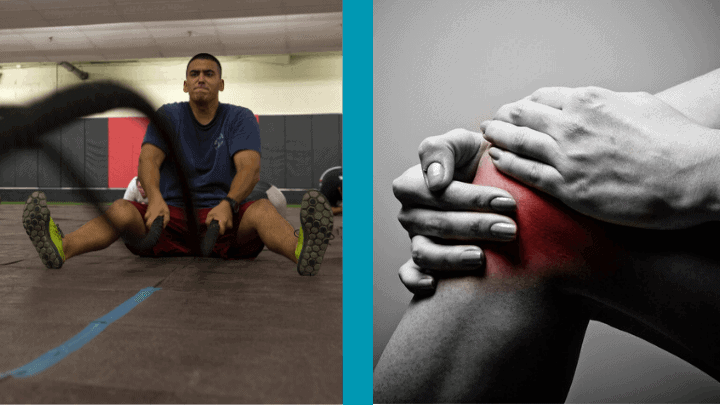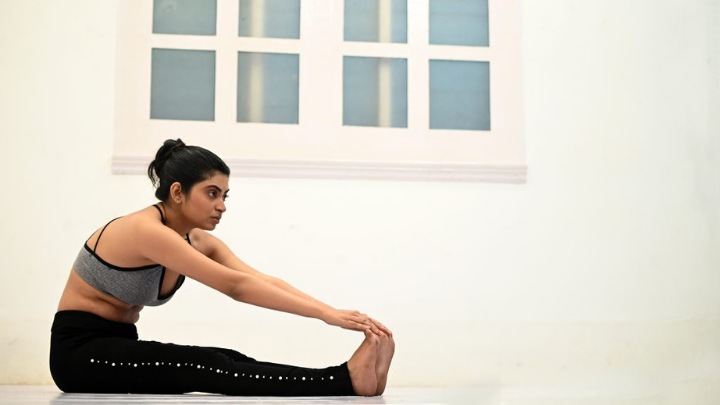You’re about to discover the top eight lunge variations you can do with kettlebells.
On top of that, you’re going to learn:
- The importance of incorporating kettlebell lunges into your training
- The comparison between kettlebells and dumbells/barbells and which piece of equipment is best
- A beginner-intermediate level kettlebell workout (with three kettlebell exercises)
- Plus lots more
Are you ready to discover mostly everything you need to know about kettlebell lunges?
Great, let’s jump into it:
Top 8 Variations Of The Kettlebell Lunges
Kettlebell Lunges are a fun exercise which comes in plenty of variations here are our 8 best picks!
1. Regular Kettlebell Lunges
To start off this list, we’ll give you the basics.
If you are not familiar with lunges or have never done them, the regular version may help you get a hang of the movement pattern.
This exercise is done with two kettlebells, held by your sides.
Kettlebell Lunge Execution Steps:
- Grab two kettlebells and hold them by your sides
- Stand up straight with feet close
- Look forward and keep the torso straight
- Place feet shoulder-width apart
- Take a big step forward
- Lunge down on that leg, keeping the torso straight
- Gently touch your back knee to the ground
- Push backwards and get into the starting position
- Do the same motion pattern on the opposite leg
2. One-Arm Overhead Kettlebell Lunge
One of the biggest benefits of kettlebells is their ability to engage stabilising muscles.
Second to that is the fact you can do really complex motion patterns and engage many muscles at once.
With this second exercise, you will work not only on the legs, but also the shoulders and overhead squat mobility.
One-Arm Overhead Kettlebell Lunge Execution:
- Grab a kettlebell, bend over slightly and do a kettlebell clean, then lift it over your head
- Keep the opposite arm to the side for balance
- Keep feet close and take a big step forward
- Lunge down, keeping the torso straight (gently touch your knee to the ground)
- Push back up to the initial position
- Repeat the movement on the same leg
- When done, switch the kettlebell to the other arm and repeat the same thing on the opposite side
3. Two-Arm Overhead Kettlebell Lunge
If you’re having a hard time developing that overhead squat mobility, the two-arm version of the kettlebell lunge may be even better.
With this exercise it would be more adequate to alternate between legs, rather than completing one set for each leg, separately.
Two-Arm Overhead Kettlebell Lunges Execution:
- Grab two kettlebells, bend over slightly and snatch them up to shoulder level, then lift them up and over your head
- Keeping that static position, take a big step forward, keeping the torso straight
- Lunge down slowly, gently touching your knee to the ground
- Push back up to the initial position and do the same on the opposite leg
- Alternate between legs
4. Alternating Reverse Lunge with Kettlebell Pass-Through
Another physical quality that traditional weight training can’t develop optimally, is coordination between limbs.
This is where the lunge pass-through can come into play, to help you develop not only strength and coordination, but also core stability.
Alternating Reverse Lunge Kettlebell Pass-Through Execution:
- Take a kettlebell with your right arm and hold it to the side
- Step with your feet close to one another and keep torso straight
- Look forward and take a big step forward with the left leg
- Lunge down
- When you are at the lowest portion of the lunge, pass the kettlebell under your left leg and grab it with the left arm
- Lunge up and forward
- Repeat the same on the right leg and alternate between sides while walking forward
- As you advance, go directly from left step forward to right step forward without stopping at the middle. This is the best range of motion to develop stability and coordination.
Note: If you are uncertain of this exercise, make sure to have a personal trainer watch over your form.
5. Goblet Kettlebell Lunge
This fifth exercise is essentially a regular kettlebell lunge, but done with a single kettlebell.
Besides improving strength and conditioning in the lower body (quadriceps, glutes, hamstrings), the goblet kettlebell lunge can help you develop static elbow flexion lockout strength, as you are holding the dumbbell in front of the chest with both arms.
Goblet Kettlebell Lunge Execution
- Grab a kettlebell with both arms and lift it up to chest level (hold it comfortably)
- Keep torso straight and feet close
- Take a step forward with one leg and lunge down
- Avoid hitting the back knee hard into the ground
- Lunge back to the initial position
- Repeat the movement pattern on the opposite side
6. Single Arm Kettlebell Reverse Lunge, Clean and Press
Now if you want an advanced compound exercise, this sixth movement we have for you may be just what you were looking for.
While the overhead kettlebell lunge will develop static, lockout strength, this one will dynamically involve the shoulder musculature with an overhead press.
Single Arm Kettlebell Reverse Lunge, Clean and Press Execution:
- Grab one kettlebell and lift it up to your shoulder level, keeping the elbows in front of the body
- Stand up straight with feet a couple of centimetres apart
- While keeping the back straight, take a big step backwards with one leg
- Lunge down until your knee is gently resting on the ground
- Push the kettlebell over your head and slowly return to your shoulder
- Step back up to the initial position and repeat on the opposite leg
7. Kettlebell Side Lunge
With modern-day sedentary lifestyle, hip tightness is a very common thing among people.
This may cause a lack of mobility and chronic pain or discomfort in that area.
Well, if that’s the case with you, the side lunge might as well be one of the best hip mobility exercises you can do.
Note that in the very beginning, given that you’ve never done it, you will more than likely need just your bodyweight.
Kettlebell Side Lunge Execution:
- Grab a kettlebell and hold it with both hands at chest level, like you would for the goblet lunge
- Step with your feet slightly more than shoulder-width apart
- Keep torso straight
- Lunge down to one side slowly, keeping the torso and core balanced by engaging both
- Stay down for a split second
- Return to the initial position
- Do the same on the opposite side
- As you progress, go directly from one side to the other, without stopping in the middle
Note: If this exercise is hard for you, replace it with a split squat
8. Kettlebell Reverse Lunge
The vestibular apparatus, responsible for balance and orientation does well when you see what’s in front of you.
When you move backwards, opposite to what you see in front, it gets different.
This is one of the best lunge variations to help develop lower body balance.
Kettlebell Reverse Lunge Execution:
- Take two kettlebells and keep them by your sides
- Keep torso straight and head looking forward
- Step with feet parallel to one another, placed at about shoulder-width
- Take a step back and lunge down carefully, maintaining core stability
- Return back to the initial position and repeat on the opposite leg
Kettlebell Workout With Four Exercises
We get it, 8 variations may be too much for you to handle in one single workout.
You don’t necessarily have to use all of them at once!
Your best bet would be to pick a couple of exercises from the list, and combine them with other lower-body kettlebell exercises, to make for the perfect leg workout.
To change up the exercise and engage more muscle groups and fibres, you can utilize different variations of lunges.
Throw in some steady state cardio after the weighted workout and you’ll be pretty much done!
Here are our TOP 3 picks for kettlebell and bodyweight exercises, as well as lunge variations to combine in a workout:
1. Kettlebell swings
After a good full body warm up, the workout can start with kettlebell swings.
This is quite a dynamic exercise that activates your legs, shoulders and lower back.
The execution of it is quite simple:
- Stand with your feet wider than shoulder width
- Grab a kettlebell with both hands and let it hang down freely between your legs
- Bend over and let it go between your legs, stretching the hamstrings and keeping torso straight
- Extend the torso up, swinging the kettlebell
- Contract the glutes up top and repeat the motion pattern
2. Walking lunges
Static lunges are cool, but eventually they become too easy.
This is exactly when you can start utilizing the walking lunge variation.
Walking lunges generally require more focus and more balance, hence, engaging more of the balancing muscles.
The walking lunge, when done correctly, looks something like this:
- Step forward
- Lunge down
- Go up on the front leg and proceed to stepping forward with the opposite leg
3. Kettlebell Side lunges
Just going forwards or backwards won’t cut it.
The legs are really functional and can cover a vast variety of angles, including going side to side.
Including side lunges into your workouts allows you to develop more hip, knee and ankle mobility, while also activating different zones of the leg muscles.
4. Split-Squat Jump
When using weights in a leg workout, at one point, you might feel stiff.
This stiffness can lead to feeling clumsy, which is exactly where jumps can be useful.
Whether you are working with barbells, dumbbells and machines or just kettlebells, we ALWAYS recommend finishing the workout with some form of bodyweight jumps.
In this workout, the split squat jump is a great explosive exercise that’ll help improve the explosiveness in your lower body musculature.
The Importance Of Kettlebell Lunges

Kettlebell lunges are an exercise that may help bring greater diversity to your lower body workouts like no other movement as they work muscles in different ranges of motion, improve balance, and can help you lose weight.
You see, squats and leg presses are not all there is to lower body training.
The lower limbs of the body have many more functions, which is why we can perform a variety of movements, such as:
- Lunging
- Sprinting
- Running upstairs
- Jumping
While heavy compound exercises are the best option for muscle and strength development, doing more dynamic movements such as kettlebell lunges can:
- Provide greater hip mobility: Increases range of motion (ROM) that improves your functional everyday movements
- Improves balance and coordination: Lunges are a unilateral exercise where the single-leg movement pattern requires stabilisation from your core and back
- Can aid in weight loss: Kettlebell lunges strengthen large lower body muscles that can reduce body fat.
If you are having a hard time doing some of the kettlebell lunges outlined in this article, it would be best to just do bodyweight lunges as your goal with lunges should be on strengthening your lower body in a dynamic way which helps to mobilise stiff hips and improve your balance.
When bodyweight lunges become too easy, then, and only then, should you look to incorporate more resistance (weight) which could be in the form of kettlebells or weighted vests which you can get online here.
Kettlebells vs. Barbells and Dumbbells

Alright, you can combine different kettlebell lunge variations and exercises, but should you throw in barbells and dumbbells as well?
Well, if you go to any commercial gym, you can instantly see a couple of free-weight modalities:
- Dumbbells
- Barbells
- Kettlebells
All 3 of the above have advantages, disadvantages and certain means of use.
However, there is one question that surrounds free weights.
That is, which one is better?
When it comes to this comparison, there is one thing we can say for sure, and that is namely the fact that none of the 3 is best all-around.
All 3 have their applications, which is why we should make use of all 3 types of equipment, in specific cases.
Kettlebells For Dynamic Exercises
When it comes to doing explosive and dynamic movements, kettlebells are king.
If you are primarily training for a discipline that requires explosiveness, such as sprinting, kettlebells might turn out to be your best friend.
The reason being is that kettlebells can target many different muscles in dynamic movement patterns.
Think about the kettlebell swing for example, it’s a very dynamic exercise that goes all the way down from the shoulders to the glutes.
Dumbbells And Barbells For Heavy Compounds
Especially if you are a beginner, odds are you are still learning the proper execution of basic, compound movements.
The best way to do so, is by using barbells and dumbbells, simply because they are not as tough to use as kettlebells.
In some instances, such as a lunge, the kettlebell might not be the best and most comfortable option for beginners.
This is exactly why a dumbbell or a barbell can be your best option if you are looking for massive strength and muscle gains.
If however, you just want to diversify, get more dynamic, work on stability and break loose from the chains of the fatiguing heavy weights, then kettlebells are your best option.
You can find a pair of dumbbells, kettlebells, and barbells online here.
Conclusion
The lunge is one of the best exercises to target the quads, hamstrings and glutes, while also engaging the lower back and the rest of the core to stabilise the torso.
Using the kettlebell lunge and its variations in your kettlebell training routine may be one of the best tools for lower body development.
Even if you are mostly engaged in strength training with barbells and dumbbells, including dynamic kettlebell exercises can be good for breaking up stiffness and developing more mobility.
Ultimately, you should be looking to include as many free weight exercises as possible, simply because all of them have a certain benefit, that can improve your muscular performance and looks.
Over to you:
What have you learnt from this kettlebell lunge guide?
Have you found a useful lunge variation that you can use in your workout?
Or perhaps you’ve learnt how important kettlebell lunges are for lower body mobility and posture.
Either way, let us know by leaving a comment below!







